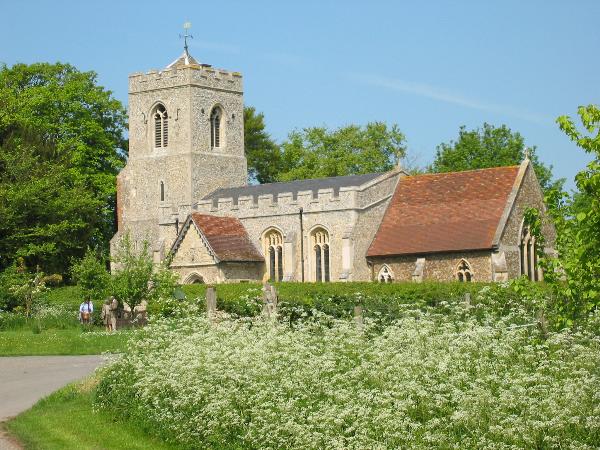
St Michael and
All Angels from near the cache site.
Abington
Pigotts is a picturesque village situated in rural South
Cambridgeshire about 4 miles north-west of Royston. It has been
variously known as Abington-in-the-Clay,
Abington-juxta-Shingay or just Abington. The first
name is apt; the local mud sticks to your boots like glue if you
walk across the surrounding fields in
winter.
A local story has it that a
previous Lord of the Manor, who’s family has been resident since
the 14th century, became frustrated by the confusion with
Abington to the south of Cambridge. His solution was to add the
Pigott family name to that of the village. I imagine there
were few objections: in those days villagers would have been
completely dependent upon him for food and shelter, and probably to
his relations for spiritual guidance. The idea was not
completely successful however; lost delivery men are still heard
cursing their Sat Nav’s for taking them nearly 15 miles out of
their way.
St. Michael and All
Angels is described as “in the Early English and Decorated
styles”, and is typical of South Cambridgeshire or North
Hertfordshire churches. It consists of a chancel, a nave, an
impressive porch, a vestry and an embattled tower containing 4
bells. It appears to originate from the 13th century; an ancient
chancel was build around 1280 but was replaced in 1875. The present
nave is considered late 14th century and the porch has the faint
remains of a date above the entrance – 1382. The tower and nave are
built of flint and chalk rubble and the buttresses contain dressed
stone, used to replace the old clunch during various restorations
since 1924. Much more recently, a further restoration of the tower
and other parts was completed; the result of a fund-raising by
villagers and grants from the Millennium Commission amongst
others.
If you are not dashing off to another
cache, the church is always open and is worth a look inside.
Visitors are very welcome and encouraged to sign the visitors’ book
but I suggest “Geocache War Child” (or whatever you’re known as
here) would raise some eyebrows at the next family service.
If you do go in, here are some
things to look out for:
-
A rare "three-decker" pulpit
consisting of a clerk’s desk, a prayer desk and a high
pulpit. The parson would occupy the prayer desk, ascending to
the high pulpit to deliver his sermon. A clerk and the
congregation would sit in descending order beneath
him.
-
Near the clerk’s desk, a wrought
iron stand to hold an hour glass. These were relatively common and
placed in full view of the preacher and congregation to limit
the sermon. A shame it wasn’t restored along with the
tower!
-
Above the pulpit is a door that
would once have opened onto a rood loft. This was a gallery above
the carved rood screen and was used for chantings and readings. The
rood screen is still present.
-
A carved Elizabethan font cover.
This was found during an earlier restoration and sits on a clunch
font originally from Foxton Church.
-
On the vestry door (directly
opposite the main entrance) can be seen the holes attributed to the
spears and bullets of Oliver Cromwell’s men. This unlikely
story appears in several old accounts of the church history, so
perhaps there is something in it.
-
A special surprise underneath
the carpet close to the altar. If you want to take a copy, please
use only your camera and replace the carpet
carefully.
See: A history
of the English parish: the culture of religion from Augustine to
Victoria, Norman John Greville Pounds
It is possible to park almost next
to the cache, in front of the church lawn. However, do take care
driving down the narrow Church Lane as horses, children
and farmers all use it occasionally. On a nice day, it’s
better to park near the pub on the main street and walk the
quarter-of-a-mile down the lane – see additional coordinates. The
walk from there is perfect for buggies and wheelchairs although the
hiding place is a few steps off the road.
If anybody would like to
expand this series please do, I would just ask that you could let
Sadexploration know first so he can keep track of the Church
numbers and names to avoid duplication.